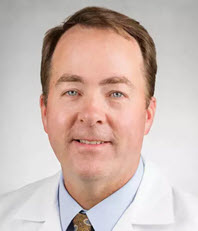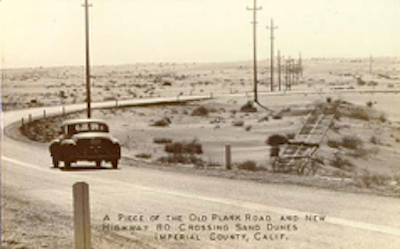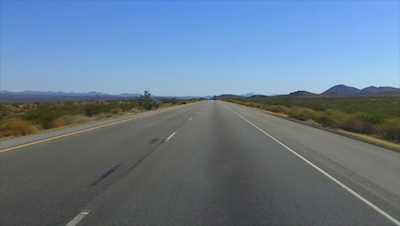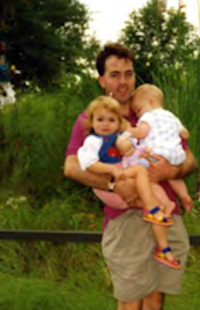Q & A with Bryan Clary
 Bryan Clary, MD, FACS, is Chair of the Department of Surgery at UC San Diego. A nationally recognized specialist in diseases of the liver, pancreas and bile ducts, he was recruited in 2015, from Duke University where he served on faculty for 15 years. In this interview, he discusses challenges and opportunities ahead for the Department and the surgical field; and looks back on what shaped him as a surgeon, and what it was like to grow up in San Diego’s neighbor to the east, Imperial Valley.
Bryan Clary, MD, FACS, is Chair of the Department of Surgery at UC San Diego. A nationally recognized specialist in diseases of the liver, pancreas and bile ducts, he was recruited in 2015, from Duke University where he served on faculty for 15 years. In this interview, he discusses challenges and opportunities ahead for the Department and the surgical field; and looks back on what shaped him as a surgeon, and what it was like to grow up in San Diego’s neighbor to the east, Imperial Valley.
December 20, 2017 | Interview by Lindsay Morgan
Where did you grow up?
I was born in Camden, New Jersey, across the river from Philadelphia. We only lived there for a couple years. My dad served as a civilian in Vietnam, helping to install defense department computers. While he was doing that, we went to live in Imperial Valley where both my mom and dad were from. I grew up in Imperial, a small town of about 3,000 at that time which has now blossomed to over 10,000.
What did it look like?
 It was flat and surrounded by mountains on most of the sides, except to the south, which is Mexico. It’s below sea level, and without water from the Colorado River, it’s desolate and relatively barren. And it is hot with high temperatures regularly reaching 115 degrees during July and most of August. The unobstructed view of green fields made possible through irrigation is for many who live there truly pleasing to the eye.
It was flat and surrounded by mountains on most of the sides, except to the south, which is Mexico. It’s below sea level, and without water from the Colorado River, it’s desolate and relatively barren. And it is hot with high temperatures regularly reaching 115 degrees during July and most of August. The unobstructed view of green fields made possible through irrigation is for many who live there truly pleasing to the eye.
How did growing up in the Imperial Valley shape you?
My maternal grandfather was a Protestant minister in the high desert communities of Southern California who moved to Imperial Valley to lead a small community church. He died when I was five so I never knew him well. But stories about him made an impression on me—he was very well-respected in the community and would give the shirt off his back to help folks in difficult circumstances. I wanted to do something that was noble, too, where you can tangibly help people. Making a living in the Imperial Valley was not easy nor was tolerating the climate. Folks there had universally positive attitudes, worked hard, and were committed to their community. Although the population was small, there was no shortage of coaches, teachers, church members, and other great role models invested in my success.
There are lots of ways to help people. Why medicine?
I’d like to say that I had a really sophisticated thought process about being a surgeon but I really didn’t. My family was completely non-medical except for a very remote relative many times removed who was a radiologist near the turn of the last century. The only physician I knew was the family practice doctor in town, Dr. Hayworth who I went to for asthma and check-ups. Fortunately, M.A.S.H. was on TV those days.
That’s a great show.
It was in its heyday when I was in high school. I saw in it what looked like a rewarding job, a job where you can challenge yourself, intellectually and physically. It seemed like a reasonable pathway towards helping people and challenging one’s self along the way. I basically had no idea what I was getting myself into. I knew only enough that I would need to get really good grades in college and stay out of trouble.
After completing the bioengineering program here at UCSD, you went to UCSF for medical school; did your residency training at Duke; followed by a fellowship at Memorial Sloan Kettering in surgical oncology. Tell me about the narrowing of interest over time.
I got into UCSF, off the wait list, in the summer. Obviously, I wasn’t their first choice.I actually went into undergrad thinking I wanted to be an orthopedic surgeon. But the Chair of Surgery (Haile Debas) was an incredible GI [gastrointestinal] surgeon and researcher, who was also very genuine and nice. The concept that you could be accomplished and nice didn’t fit the surgical persona back in that era. He made general surgery and GI surgery specifically seem really exciting.
I came out of medical school wanting to do general surgery. The issue was: where? When I visited Duke during interviews, number one, I didn’t mind that it was in Durham, North Carolina—that was still a huge metropolis as far as I was concerned. But not only that, when you interviewed there, they exposed you to almost all the residents in the program. Commonly when you interview, they might have one or two token residents, and maybe they’re the only happy ones in the program. But Duke had a dinner where you met a large number of residents. And overall, they seemed normal and happy and very accomplished. Ultimately I saw in them and the recent graduates what I thought I wanted to be.
I matched to the program, and, against the advice of almost everybody in California, we left and went to North Carolina. I was recently married to an Orange County (CA) native who was relatively fresh out of veterinary school and a real trooper for setting out on this journey that would take us away from the comforts of coastal California. We caught the I-40 at Barstow and just took it all the way to Durham.

You spent about 22 years at Duke between training and being on faculty for almost 15 years. How were you shaped as an academic surgeon during that time?
Dr. David Sabiston, the Chair, was eminently successful at developing academic surgeons. About 70% of the graduates matriculated to academic surgical jobs—a very high percentage. He wholeheartedly believed in the need to have surgeons who did research. He thought it made them better clinicians and he believed it was the only way that things were going to progress. Because of this, he created a structure and committed resources to make it happen. That model had a huge impact on me.
What were some of your proudest accomplishments at Duke?
We did a really good job with liver surgery, and our clinical outcomes were top decile. The second thing I was proud of was education. I became program director for surgery residency at Duke in 2007, and had the privilege, for six years, of leading what I thought was one of the best surgery residency programs in the world.
On the research side, we were productive as a group in contributing to the literature on how to do liver surgery better. My laboratory was independently funded through foundations and the NIH and our group contributed to the national conversation on the role of surgery in liver, pancreatic, and biliary diseases and even if for a brief period of time, helped to move these fields forward. If I am honest with myself, my research accomplishments while decent were not as robust as I had hoped, largely because I didn’t dedicate enough time. My clinical practice was very large and time consuming as were the administrative responsibilities of running one of the largest residency programs in the hospital. There are only so many hours in the day, a fact that I could not change.
Speaking of hours in the day, surgeons devote a huge amount of time to their work life. It strikes me as analogous to induction into the military or into a holy order. But you guys are normal people and you have spouses and kids. How did you balance that?
I had a very supportive and enabling environment at home. My wife is a very accomplished veterinarian, but by the time I finished my training as a fellow at Memorial Sloan Kettering in New York , number four was on the way, and she decided that she would rather be at home than be a vet. Our own collection of animals that included dogs, cats, guinea pigs, rabbits, a ferret, and a horse kept perhaps provided her some relief from the doldrums and often thankless job of being at home.
 Part of finding balance was how you structured your days. When the kids were really young and I was a junior faculty member, I’d go home around 6, be there for dinner and hang out with family a bit, then I would go back to the lab at night and/or round on my patients. As an aside, my wife would find it laughable to hear me talk about “balance”.
Part of finding balance was how you structured your days. When the kids were really young and I was a junior faculty member, I’d go home around 6, be there for dinner and hang out with family a bit, then I would go back to the lab at night and/or round on my patients. As an aside, my wife would find it laughable to hear me talk about “balance”.
I don’t pretend to give people marital advice but you can’t be a partner with or marry someone who needs you there 24 hours a day. That’s just not happening. Patients get sick at inconvenient times, they get sick on the holidays, they get sick at night. While I like to joke that one should “marry low-maintenance and drive expectations down immediately”, it is not too far from the truth of my own experience.
Admittedly I struggle with many current discussions surrounding “work-life balance”. We aren’t put on this earth to just enjoy ourselves. More importantly we are here to serve each other. This certainly entails serving our children and attending to their needs, but it must extend outside the family environment too. The other part is, I think folks over-emphasize their children a little bit. I really like my kids. I want to know them. But what better thing can you do for them than to model a life that is not all about me or them, but instead is about others. I think that’s one of the best gifts you can give them. And I think you can do that in a healthy way.
Why did you decide to come home to San Diego?
When you get to be about 10 years into your practice, you come to a point where you have to ask yourself: Is this all there is? Am I happy? At Duke, I was very happy. But as I looked 5 and 10 years down the road, I thought that perhaps I could have a bigger impact for patients by facilitating the success of others. I wanted to continue to live in the academic surgical space, so I began to look at Chair opportunities. There were a number of things I hoped to have in securing a position as a Chair of Surgery. I wanted an environment where the undergraduate and graduate campuses were co-localized. Where there were really strong engineering programs. I wanted to be in a place where there was a high-quality Veteran’s hospital co-localized. And I wanted to be in an environment that was growing and viable.
A job opened at UC San Diego, and it seemed like the things that I wanted were all here. On top of this, UC San Diego was in the process of formalizing an affiliation with a hospital near my hometown that would afford me the opportunity to be engaged in the health of the community that had done so much for me.
What are some of the big challenges you’re keen on tackling here as chair?
From a clinical perspective, the principle challenge is how do we secure our ability to reach as many of the region’s patients with our unique talents. A few years ago, the health system leadership began a clinical integration network, which quickly increased our network of primary oriented practices. For the Department, the issue is: how do we serve that network? We need quick access, and we need availability. That has meant the growth of faculty and also requires us to be out in communities. So, we have cardiothoracic surgeons in Temecula and Tri-City. We’re involved in expanding surgical services in El Centro and we provide important consulting services for Eisenhower Health Centers in Palm Springs.
The other major challenge and opportunity is down in Hillcrest. Even after the opening of the Jacobs Medical Center, which has essentially doubled the operating room footprint for La Jolla, Hillcrest is still just as large from an inpatient perspective, and provides important services that we would not duplicate for a variety of reasons in La Jolla—particularly the acute care programs, burn center, trauma services. I think we swung the pendulum a little too much into La Jolla and I think we can shift it back a little and expand certain services in the Hillcrest community. Important areas for us in that regard are management of common cancer problems, general vascular services, general ENT, and wound management.
The Department has residency programs in general surgery, otolaryngology, and plastic surgery; and fellowships in breast surgical oncology,burn, cardiovascular and thoracic surgery,craniofacial surgery, minimally invasive surgery,neurotology and skull-base surgery,surgical critical care, and vascular surgery. What are the challenges ahead in training?
One of them is to look at our current educational offerings and ask if they’re the right ones. In some specialties there are moves to restructure or redefine what that training paradigm looks like. For example, plastic surgery training is increasingly done through integrated programs where from day one after medical school, residents are matched into plastic surgery. Dr. Amanda Gosman helped lead our plastic surgery paradigm to an integrated format. We’ll have to sort out whether we need to do that in other areas. Identifying ways in which to shorten our clinical training programs and in developing better strategies for assessing educational development and competency are also big issues for the near future.
Another challenge is defining the mission of our programs. Is it just the mission to produce clinicians for California because we’re a UC system? Or is our mission to develop the future academic surgical leaders who are going to help define, reshape, and improve their fields? I would argue that our mission is a combination of both.
How do you develop future academic surgeons?
First, you provide them with the best possible clinical training, and then you provide defined opportunities to do research. That takes resources to do well. It also involves exposing residents to different ways of thinking, to visiting professors who give them examples beyond their own faculty of what successful academic surgeons look like. Having them engage with surgical societies in this early stage in their development is also critical. It’s also incumbent on the Department of Surgery to engage students at the medical school level and even at the undergraduate level to get them excited about what we’re doing. And then the other part of it is, when they finish their training, we need to be involved in helping them navigate, whether they are faculty at UC San Diego or not.
Another element is picking the right people from the start. Residency education is a combination of service and education. It’s not a purely education and it is not solely a job. Residents invest themselves, they provide an incredible amount of labor in the service of our patients, but they also come away with the gift of an incredible career that has been facilitated by the education that they have received. We need to re-emphasize that, even to ourselves as faculty members. What we get to do every day is a gift. Where residents sometimes have difficulty is when they (or more importantly we the faculty) view it as just labor.
What about big challenges on the research front?
Surgery remains variably effective, morbid, and costly. What is there not to study? Indeed it is our responsibility through research to change things for the better. The principal challenges are in finding individuals who are internally motivated to conduct research and in securing the time and resources for them to do so. Much of this boils down to the short-term economics of surgeons doing research. Financial incentives on the part of hospitals and practicioners are clearly aligned more towards doing surgery than doing things that are academic in nature. There are also some structural issues about skills maintenance, managing your patients after you operate on them. Surgeons who are active clinically can’t typically devote the same amount of time to their academic pursuits as in other disciplines. You have to be very thoughtful and strategic about doing research and you need supportive departmental leadership.
What is in your power to do as chair to enable your faculty?
You need to select the right people. As Allen Kirk pointed out last May at our research symposium, the value of doing research “is that you get to do research”. What an exciting thing, to develop new knowledge, to move your field forward. You have to select people who understand that intrinsic value of academic activities.
Then you need to support them. And you have to develop a structure. You need to resource them properly, and you need to embed them in environments that are going to make them successful, and commonly that involves multidisciplinary collaborative research.
What about enhancing department collaborations with the School of Engineering and other UC San Diego departments?
The School of Engineering is an incredible resource—it’s in the top 10, and they are really hungry for clinical collaboration. We also have the Institute of Engineering in Medicine which is really unique among engineering programs. The basis for having robust relationships between surgical sciences and engineering—I don’t know that there’s a better place in the country for that.
Data science is another really important piece. The informatics program led by Lucila Ohno-Machado is an incredible resource. Electronic health records, population health—that’s all about huge data. Some people might call that soft science—outcomes-based research. But the reality is that figuring out how to do better with what we currently know how to do that would reap huge benefits.
How will you promote innovation in the Department, and what does the frontier of surgery look like?
There are certain areas in surgery where coming up with a better way to do the operation is still going to be fundamentally important. A good example is vascular surgery. About two decades ago, there began a shift from doing large, open operations with big incisions to endovascular techniques. That required different technology and even two decades later, that technology is far from perfect. I like to joke that “vascular surgeons are still making stuff up”.
But there are some diseases, like gall bladder cancer, where coming up with a better operation is not going be the answer. The bigger bang for the buck in those disease is going to be about how do you treat with better chemotherapeutics , identity diseases at early stages, and perhaps avoid surgery. We are uniquely positioned, I believe with our strong engineering ties, and the Center for the Future of Surgery, to be part of moving our fields forward.
Other areas of innovation will revolve around how we deliver care. It’s not as sexy, but it’s fundamental—how do we improve our systems so that patients don’t wait three weeks to get their appointment, how do we improve our multidisciplinary collaboration so that when people come they can see everybody they need to and don’t have to come back unnecessarily. How do we improve quality and reduce infection.
You go about once a month and work in El Centro with Dr. Luis Cajas, a graduate of the UC San Diego general surgery residency program who is working in El Centro this year before beginning a fellowship at the Mayo Clinic next June. It’s been three decades since you grew up in the Imperial Valley. What’s it like to go back?
I know the entire drive and I could do it blindfolded. I know every landmark. Even though it’s a two-hour drive from La Jolla, it seems like 10 minutes. I have extraordinarily fond recollections of how important the Valley was in my growing up.
And I like it. I like looking out and seeing across the horizon for a bazillion miles. It is, to me, a very beautiful and peaceful place. I have many friends and family who still live there. And they don’t know me as who I am in my position here, they just know me from what I was when I was there.
There is substantial poverty in El Centro and as such many of the Valley residents can’t just pop over the hill and get medical care. Nor should they feel the need to for common community conditions. In partnership with El Centro Regional Medical Center and many excellent local practitioners, we are working to improve the quality of care that is delivered in the Valley.
What has been the most surprising thing about being a Chair?
I had such good examples of what the job was going to be so there’s nothing typically surprising.
Is it lonely at the top?
It is a little bit. The relationships that you have, you have to be more thoughtful about how you say things and what you do. I like sarcastic wit but that doesn’t play too well and you have to be much more serious when you’re in a senior leadership role. But no, folks have been quite generous here in their time and efforts.
If your kids had one word to describe you, what do you think it would be?
I think they would say generous. Maybe not financially to them, but overall. And, I know it’s hard to imagine, but humorous.
What is the word you would most like to live up to?
Generous. In all things.
Do you ever think, if you had another life, that you would be something else?
I would have loved to be a left-handed pitcher for the Dodgers or a professional tennis player. But I honestly can’t think of a better job than what I am currently doing.
